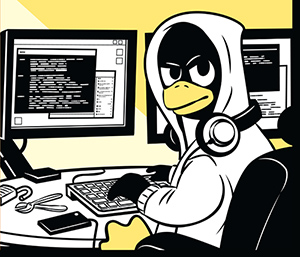Livin' la vida Linux, Ep. 0 "The Beginning"
I started my Linux journey a little over a year ago and can emphatically declare that it has definitely changed my life for the better. The freedom and peace of mind that Linux affords cannot be overstated. Plus, it makes me feel like a secret agent.

Windows loses. Every time I use it, I am reminded of why I left it. It’s slow, crashy, and has a ton of crapware. Every time I update, there’s more crap I don’t want that I cannot delete. Windows is also very nosy and a cesspool for malware.
Where Windows shines, however, is the Microsoft Office suite. I have not been able to find a reasonable replacement. Browser-based Office365 is not ready for Primetime. LibreOffice, the Linux-based Office alternative is adequate, but it just doesn’t do it for me. The fact that MS Office (I know MS Office is on Mac, but it’s not the same) and many other third-party programs are only available on PC is the only reason I haven’t gotten rid of Windows completely on two of my machines. WineHQ is a program that allows you to run Windows programs on a POSIX system – think macOS, Linux, BSD, etc – but I found it challenging and tabled it for another day.
MacOS is a great operating system; my problem is the Apple ecosystem. They have been notorious for planned obsolescence in their hardware and software. Upgrading my OS broke several of my expensive programs. Soon as you get used to the 30-pin connector, here comes the lighting cable. Now they are switching to their in-house chips instead of Intel. If the iCloud and overall Apple ecosystem work for you, great. But I like the freedom to change devices on a whim. I change devices like I change draw’s. I will rock a Blackberry, a Samsung Galaxy Note or an iPhone at any given moment. Linux gives you the freedom and versatility to live your life out of Microsoft and Apple’s proprietary walled gardens.
Unlike Windows and Mac, Linux comes in a variety of flavors called distributions or “distros.” Distros are fully customizable and can be as pared down or as beefed up as you want. My first distro ever was CentOS, a community-based fork of Red Hat Enterprise Linux (RHEL). I didn’t know what on earth I was doing and installed a minimal, command-line only version as a dual boot on my laptop. After that ordeal, I checked out Chris Negus’s The Linux Bible from the local library. In the book, he recommends Fedora. I never looked back.
Fedora is a cutting-edge, state-of-the-art distro that updates every 6 months. Fedora is upstream from RHEL, meaning that it is a testing ground for the latest and greatest features that may or may not be added to RHEL down the road.
Fedora just works out of the box. I’ve never run into any problems running it via live USB or installing it to any device. I would recommend it to a seasoned Linux user or a newbie. It is simple, not bloated, yet powerful enough for modern computing. The GNOME desktop environment has been revamped with touch in mind, so using the touchscreen on my 11” Lenovo Flex was a joy. Linux is under the hood of Android, and mobile is becoming a promising new frontier for Linux distros, with Fedora at the vanguard.
Do you, like many, own an old desktop tower that has a floppy disk drive and is running Windows XP? Don’t throw it out just yet. Linux can breathe new life into older hardware. I wouldn’t, however, recommend Fedora for older systems. I would suggest Xubuntu, which requires less RAM and hard drive space, supports 32-bit architecture if applicable, and uses XFCE, a lightweight desktop environment. Which leads me to my next point.
Oftentimes, it’s not the distribution it’s the desktop environment that makes the difference in the user experience. The desktop environment is the graphical user interface (GUI) on top of the distro. This is where Linux gets really fun. With a few exceptions, you can put any of the popular desktop environments on any of the major distros. You can really tailor your Linux experience to your hardware profile and use case. For entry-level or older hardware, XFCE is a good option. For mid-level profiles, GNOME is standard. For newer, beefier systems, elementaryOS is available. If you’re feeling really adventurous, there is a whole world of window managers that focus more on command line terminal windows but offer GUI support, but that’s another post for another day.
If you are interested in getting started with Linux, there are a few things you should know. Don’t think everything is just going to work automatically like Windows or Mac. You will have to get your hands dirty in the command line. You may have to put some effort into getting hardware or connected peripherals working. You might botch your install and have to start over, which is why it’s important to ALWAYS BACK UP IMPORTANT FILES! All things considered, your skill level will improve as time progresses and for most distros, there is a ton of community support via Google, documentation, forums, and Youtube videos.
I will do a follow-up post on various distros and which ones work best for what situations. In the meantime, getting started with Fedora is simple. You will need a USB flash drive, Internet access, administrator privileges and the Balena Etcher live media creator. They also have a convenient tool called the Fedora Media Writer, which streamlines the process.
Happy Linuxing!
